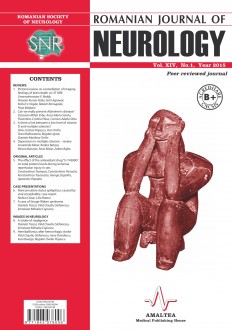SELECT ISSUE

Indexed

| |

|
|
|
| |
|
|
|

|
|
|
|
|
|
| |
|
|
HIGHLIGHTS
National Awards “Science and Research”
NEW! RJN has announced the annually National Award for "Science and Research" for the best scientific articles published throughout the year in the official journal.
Read the Recommendations for the Conduct, Reporting, Editing, and Publication of Scholarly work in Medical Journals.
The published medical research literature is a global public good. Medical journal editors have a social responsibility to promote global health by publishing, whenever possible, research that furthers health worldwide.
HEMIBALLISMUS AFTER HEMORRHAGIC STROKE
Vlad Claudiu Stefanescu, Irene Davidescu, Ioan Buraga and Bogdan Ovidiu Popescu
INTRODUCTION
Ischemic or hemorrhagic stroke may be accompanied by movement disorders (1), either hyperkinetic or hypokinetic. Hyperkinetic movement disorders after stroke comprise dystonia (2-4), chorea with or without hemiballismus (5), tremor (6), parkinsonism (7), segmental or focal myoclonus, athetosis, pseudathetosis, and asterixis (8). Hemiballismus is a movement disorder characterized by involuntary, arrythmic, and large amplitude excursion of a limb, usually from a proximal joint, witn an element of rotation (9). Ballismus is explainable with lesions in the subthalamic nuclei, cerebral cortex, corpus striatum, thalamus and brainstem. (10) The frequency of post-stroke abnormal movements is unclear, the prevalence in a swiss registry being 1% with an incidence of 0.08% per year (8). Of them, hemichorea-hemiballismus is the most common, while dystonia is the next most common disorder (11).
Full text | PDF
